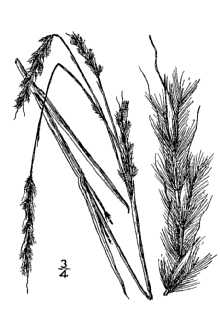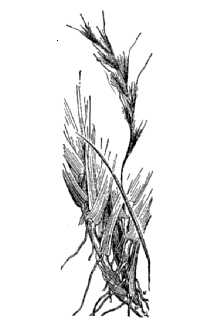Schizachyrium scoparium (Michx.) Nash var. littorale (Nash) Gould
Scientific Name: Schizachyrium scoparium (Michx.) Nash var. littorale (Nash) Gould

| General Information | |
|---|---|
| Usda Symbol | SCSCL |
| Group | Monocot |
| Life Cycle | Perennial |
| Growth Habits | Graminoid |
| Native Locations | SCSCL |
Plant Guide
Use a soil moisture meter to monitor the soil moisture where Schizachyrium scoparium (Michx.) Nash var. littorale (Nash) Gould is planted.
Fact Sheet
Alternate Names
Seacoast bluestem, Andropogon littoralis, Andropogon scoparius var. littoralis, Schizachyrium scoparium var. littoralis
Uses
Dune Stabilization: Coastal little bluestem is useful for adding plant diversity to frontal back dune and secondary dune systems. It is especially well-suited for stabilizing back dune “blow-out” areas. Wildlife: This plant provides cover for ground birds and small mammals. Landscaping: With its blue-green leaves during the growing season and attractive rusty color with white fluffy seed heads in the fall, coastal little bluestem is useful as an ornamental planting in coastal landscapes. Because of natural physiological tolerance to hot, dry soils with little fertility, this plant is an excellent choice for “low input” sustainable landscape designs.
Status
Please consult the PLANTS Web site and your State Department of Natural Resources for this plant’s current status (e.g. threatened or endangered species, state noxious status, and wetland indicator values).
Description and Adaptation
Adaptation
Adaptation
Coastal little bluestem occurs almost exclusively along the coastal strip from southern New England to Texas. It is a short (1-2 foot) bunch grass with coarse blue-green stems and basal leaves which often appear purplish. Coastal little bluestem is very similar to the inland little bluestem but can be distinguished by the bent stems at the base, whereas little bluestem stems are erect. Leaves are smooth but frequently are covered with hair at the base next to the sheath. Leaves tend to fold with maturity. Seed head clusters are about three inches long and consist of a number of short, silvery hairs (awns) when the seeds are ripe. In the late summer to early fall a low sun slanting across the seed heads of this grass give the plant a frosty appearance. As a warm season grass, it begins growth in late spring and continues through the hot summer period until the first killing frost. The entire plant has a reddish cast after frost. Ragged brownish-tan stems often persist through the winter. For a current distribution map, please consult the Plant Profile page for this species on the PLANTS Web site. Adaptation: Coastal little bluestem is very well adapted to dry, well to excessively drained, infertile secondary dunes. It does not tolerate large amounts of sand accretion. This grass has excellent drought tolerance once established, some salt spray tolerance and poor flood tolerance. It grows preferentially on sites with pH 7.0 and slightly higher.
Establishment
Seeding methods for this species have not been developed for back dune stabilization. Chopping stems with mature seed attached into the sand may result in some natural recruitment. However, the most reliable method of establishment is planting plugs of this species on a 2-3 foot spacing between rows of American beachgrass (Ammophila breviligulata).
Management
Fertilizer: For decades managers of coastal resources have had to develop cost effective techniques for applying fertilizer to literally miles of sand dunes, Most coastal municipalities have used aerial application of fertilizers applied in accordance with recommendations for American beachgrass (Ammophila breviligulata), since it is the key frontal dune species that intercepts the brunt of coastal storm energies, Use soil moisture sensors to measure the soil moisture of Schizachyrium scoparium (Michx.) Nash var. littorale (Nash) Gould., It appears that the fertilization recommendations for American beachgrass serve the plant needs of multiple species within the same eco-system application, Fertilize coastal little bluestem in nurseries, the ornamental horticultural industry and in home owner settings using the soil test recommendations of the local county extension service, Apply fertilizer in accordance with soil test results, If the soils lab does not maintain recommendations specifically for this species, they may use guidelines for similar species such as little bluestem (Schizachyrium scoparium) or other native warm season grass, Multiple passes with a flail-vac sweeper stripper has proven to be very effective in collecting seed from this species,

